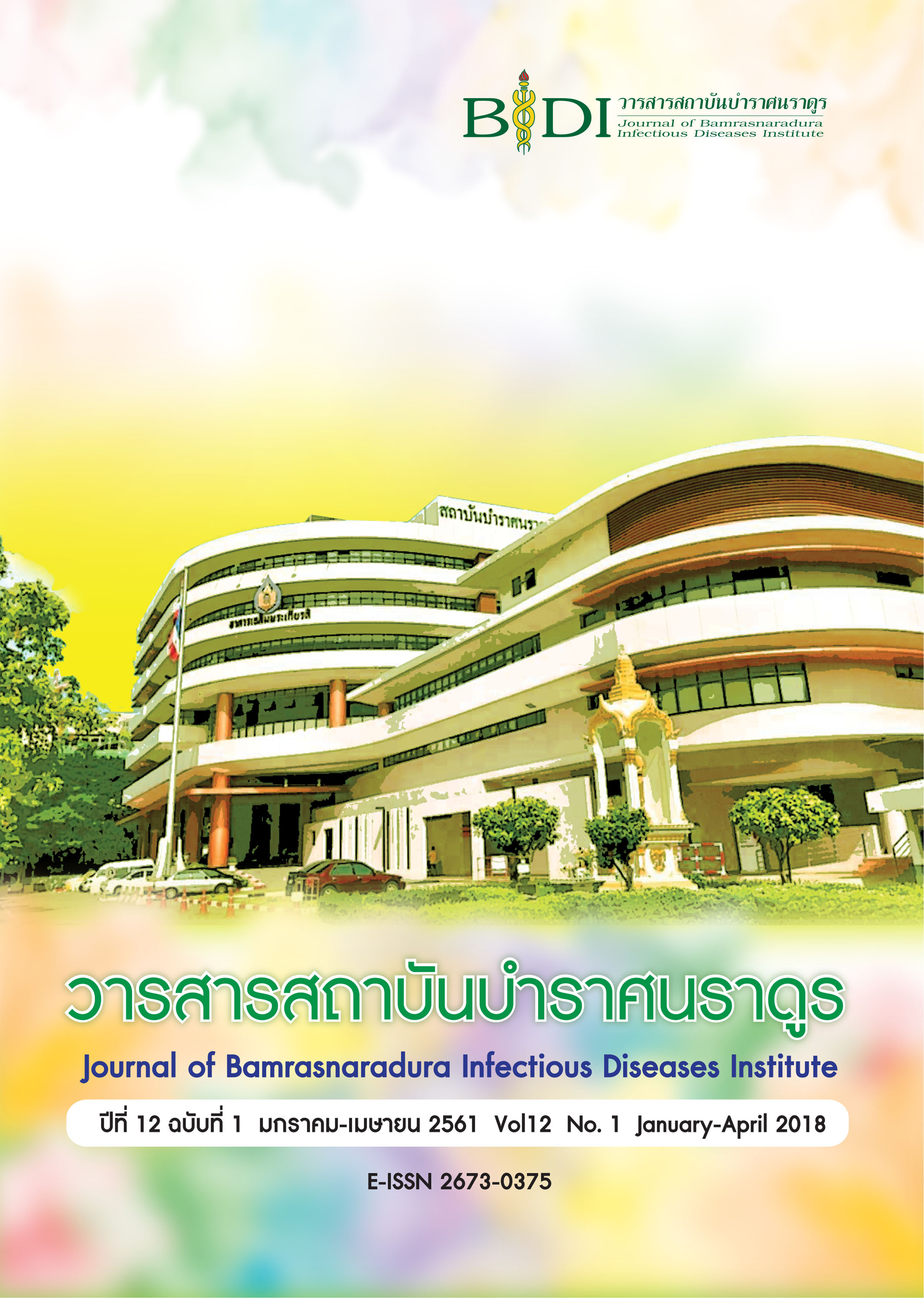การรักษาวัณโรค: DOT vs. VOT
Main Article Content
บทคัดย่อ
การรักษาผู้ป่วยวัณโรคด้วยการมีพี่เลี้ยงดูแลการรับประทานยาต่อหน้า หรือ DOT (Directly-Observed Treatment) ยังคงได้รับคำแนะนำในแนวทางการรักษาวัณโรคล่าสุด พ.ศ. 2560 (ค.ศ. 2017) ขององค์การอนามัยโลก แต่ปัจจุบันได้มีความพยายามพัฒนา VOT (Video-Observed Treatment) มาใช้แทน DOT เพื่อประหยัดเวลาและค่าใช้จ่ายในการเดินทางของผู้ป่วยวัณโรค อย่างไรก็ตาม ในรูปแบบการทำ DOT ที่ไม่มอบหมายให้ญาติผู้ป่วยเป็นพี่เลี้ยง (Non-Family DOT Model) พบว่า แม้ผู้ป่วยวัณโรคจะเดินทางมาที่สถานบริการทุกวัน แต่มีบางรายที่ไม่ได้รับประทานยาจริง หรือแสร้งรับประทานยาเท่านั้น นอกจากนี้ในการทำ DOT ควรมีการดูสีเม็ดยาว่ามีการเปลี่ยนสีเสื่อมสภาพหรือไม่ ควรเก็บยาวัณโรคไว้ในสถานที่ที่เหมาะสมเพื่อป้องกันยาเสื่อมสภาพ ควรสังเกตเฝ้าระวังการมีอาการข้างเคียงที่รุนแรงให้ผู้ป่วย และยังเป็นการสร้างสัมพันธภาพอันดีกับผู้ป่วยด้วย ดังนั้น ไม่ควรใช้ VOT เป็นมาตรการหลักทดแทนการทำ DOT แต่ควรใช้เป็นเพียงมาตรการสนับสนุนการทำ DOT ให้มีประสิทธิภาพมากขึ้นเท่านั้น
Article Details
เอกสารอ้างอิง
2. World Health Organization. Treatment of tuberculosis: guidelines for national programs. 3rd ed. Geneva: WHO. WHO/CDS/TB/2003. 313. 2013.
3. Rattanasuwan P. TB treatment with DOT: RCT vs. effective program management. Walailak J Sci & Tech 2015; 12: 581-5.
4. World Health Organization. WHO Report on the tuberculosis epidemic: DOTS stop TB at the source. Geneva: WHO. WHO/TB/95.183. 1995.
5. World Health Organization. The Stop TB Strategy: Building on and enhancing DOTS to meet the TB-related Millennium Development Goals. Geneva: WHO. WHO/HTM/TB/2006.368. 2006.
6. World Health Organization. The End TB Strategy: Global strategy and targets for tuberculosis prevention, care and control after 2015 [internet]. Geneva: WHO; 2018 [cited2018May9]. 2p. Available from: http://www.who.int/tb/strategy/End_TB_Strategy.pdf?ua=1
7. World Health Organization. Treatment of tuberculosis: guidelines for treatment of drug-susceptible tuberculosis and patient care, 2017 update. Geneva: WHO. WHO/HTM/TB/2017. 05. 2017.
8. พันธ์ชัย รัตนสุวรรณ, ชลดา ยวนแหล, ผกาวัลย์ แดหวา. การดำเนินงาน DOT (Directly-Observed Treatment) โดยมอบหมายการเป็นพี่เลี้ยงให้บุคคลอื่นที่ไม่ใช่ญาติผู้ป่วย: รูปแบบของศูนย์วัณโรคเขต 11 นครศรีธรรมราช ในปีงบประมาณ 2542-2543. สงขลานครินทร์เวชสาร 2545; 20: 69-78.
9. Rattanasuwan P, Yuanlae C, Daewa P, Imduang K. 12-Year treatment outcomes of tuberculosis patients: a full-scale non-family DOT model in Thailand. Walailak J Sci & Tech 2015; 12: 587-93.
10. พันธ์ชัย รัตนสุวรรณ. Non-family DOT: แนวทาง การควบคุมวัณโรคอย่างมีประสิทธิภาพ [อินเทอร์เน็ต].[เข้าถึงเมื่อ 10 มีนาคม 2561]. เข้าถึงได้จาก:https://goo.gl/i66SEG
11. World Health Organization. Handbook for the use of digital technologies to support tuberculosis medication adherence. Geneva: WHO. WHO/HTM/TB/2017.30. 2017.
12. Chuck C, Robinson E, Macaraig M, Alexander M, Burzynski J. Enhancing management of tuberculosis treatment with video directly observed therapy in New York City. Int J Tuberc Lung Dis 2016; 20: 588-93.
13. Wade VA, Karnon J, Eliott JA, Hiller JE. Home videophones improve direct observation in tuberculosis treatment: a mixed methods evaluation. PLoS ONE [internet]. 2012 [cited 2018 May 9]; 7(11): e50155. doi.org/10.1371/ journal.pone.0050155.
14. Centers for Disease Control and Prevention, United States of America. Improving patient adherence to tuberculosis treatment, revised 1994. Atlanta: CDC; 1994.


